Arregla tu Pop Up
Un movimiento hábil, fluido y sin esfuerzo, o una torpeza y agitación hacia el kookdom. Si tu pop up está en la categoría de torpeza y agitación, entonces este post es de lectura obligatoria en tu camino hacia un mejor surf.
El Pop Up: Es un movimiento que, o bien no es considerado por aquellos que lo ejecutan de forma impecable. O es un movimiento que se convierte en la perdición del surf. Para aquellos de vosotros que tengáis problemas y dificultades con el inicio de vuestro surf, así es como se arregla vuestro pop up.
SURF POP UP TÉCNICA
En primer lugar, debes tener claro que no hay una forma única de elevarse "correctamente". Como acabas de ver en el vídeo Pros in Slow Mo, todos se levantan de forma diferente, pero es suave, fluida y, en última instancia, da como resultado una postura erguida pero informal surf .
Algunos plantan primero el pie trasero, mientras que otros plantan los pies simultáneamente. Observarás que algunos todavía tienen las manos sobre la tabla cuando plantan el pie delantero, mientras que otros ya han empezado a enderezar el torso y los brazos mientras el pie delantero entra en contacto con la tabla.
La cuestión es la siguiente: no hay una única forma correcta, pero sí hay una serie de pautas a las que hay que aspirar.
También habrá necesidades individuales para la técnica basadas en aspectos como su altura, la longitud de su fémur, el tamaño de la tabla y lesiones articulares previas, cirugías y movilidad.
Lo que puedes y debes sacar de ese vídeo es que el movimiento es suave. No se trata tanto de un "POP"como de un casual "vamos a poner las piernas debajo de mí con fluidez para que pueda ponerme de pie y empezar a maniobrar la tabla para interactuar con la cara de la ola".
Los saltos y los golpes fuertes no son el camino a seguir. Suavízate, fluye y ponte erguido en esa postura relajada pero atlética de surf .

SURF POP UP POSICIÓN DEL CUERPO
EMPEZAR PENSANDO EN EL FINAL

¿Dónde tienes la cabeza? ¿Estás mirando la nariz de tu tabla preocupándote por el dibujo de la cara de la ola? ¿O ya estás mirando hacia la línea, afectando así a la posición de tus hombros y torso, y ya estás leyendo la física de la ola?
Tus ojos, tu cabeza, tus hombros y la posición de tu torso son un componente clave para una buena pop up. No puedes fijar tu pop up a menos que empieces a mirar hacia donde quieres ir. Ojos arriba, cabeza arriba, pop-up. Vuelve a ver el vídeo de Pro Slow Mo y presta atención a la postura de la parte superior del cuerpo antes de saltar, durante y justo después.
Si te haces una mejor idea de dónde tiene que acabar tu cuerpo y cómo tiene que empezar, el proceso intermedio será más fácil. Si necesitas empezar en A y terminar en C, deberías tener una mejor idea de lo que B necesita... bueno... ser. (Eso ha sido muy inteligente).
¿CUÁL ES SU PROBLEMA POP UP ?
Vamos a aclarar un poco cuál es tu problema, para que puedas tener una mejor idea de lo que necesitas implementar para arreglar tu ventana emergente.
Aparecer es una habilidad
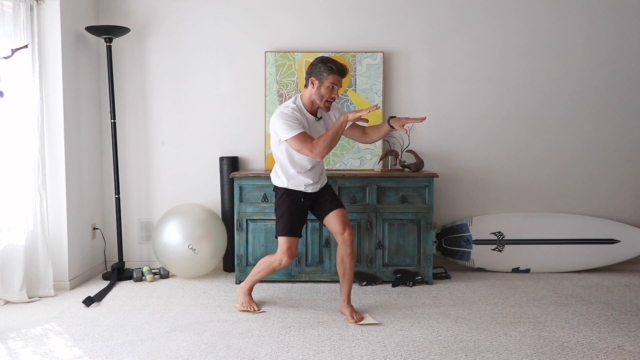
Los buenos surfistas hacen que el movimiento técnico de un pop-up parezca fácil y fluido tras años de práctica, mientras que los pop-ups ineficaces pueden crear patrones de movimiento defectuosos. Estos patrones provocan caídas con las rodillas flexionadas hacia delante y olas perdidas.
Esta habilidad es un patrón de movimiento, lo que significa que se convierte en un hábito de movimiento subconsciente. No hay que tenerlo en cuenta, ya que ocurre automáticamente. Yo lo equiparo a la facilidad con la que se puede meter una llave en el contacto de un coche sin buscar el agujero milimétrico en el que encajar la llave.
Tu sistema nervioso ha programado el patrón de movimiento del pop-up, convirtiéndolo en una reacción técnica que exige un cuerpo en pleno funcionamiento. La solución para arreglar tu pop-up es practicar la repetición perfecta y asegurarte de que tu cuerpo se mueve de la manera requerida para un pop-up exitoso.
Lo que la mayoría de los entrenadores de técnica no tienen en cuenta es si tu cuerpo, su estructura y su capacidad para moverse a través de las articulaciones es lo que está limitando la habilidad y la técnica para saltar con fluidez. Entonces, ¿puedes moverte?
LA DESTREZA SE CONSTRUYE SOBRE LA BASE DEL MOVIMIENTO
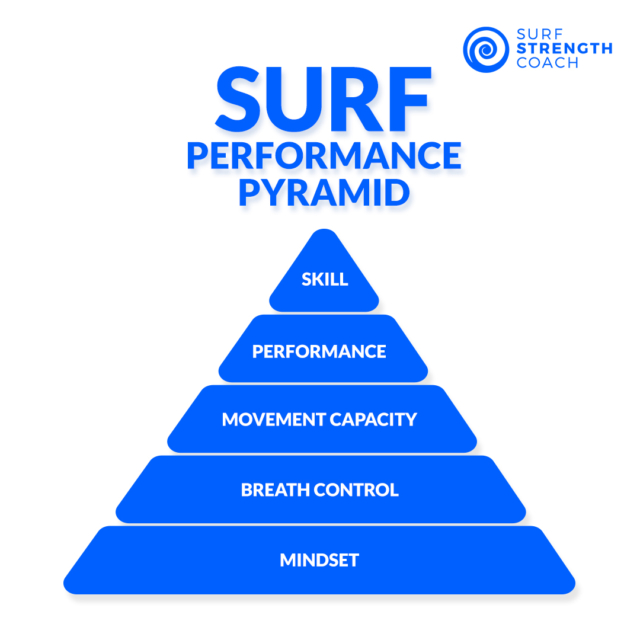
La destreza, el acto y el arte de surfear (y emerger), se construye sobre los cimientos de si tu cuerpo puede moverse bien o no. ¿Tiene tu tobillo una amplitud de movimiento adecuada? ¿Y la rodilla y la cadera?
¿Tienes suficiente control central y fuerza abdominal inferior para estabilizar la pelvis de modo que haya una "plataforma" de control para que puedas batir las caderas por debajo de ti? La capacidad de moverse a través de las articulaciones y la habilidad para controlar esos movimientos con fuerza sientan las bases de la destreza y la fluidez pop up.

¿Sabes hacer sentadillas profundas? Inténtalo ahora. Sentadilla profunda de culo a hierba. No desplomes los arcos ni gires los pies hacia fuera más de 30 grados.
¿Qué sientes? ¿Duelen las articulaciones? ¿Dónde está la restricción? ¿Una reconstrucción anterior de cadera limita tu capacidad? Tal vez una sentadilla profunda te resulte impecablemente fácil. Si es así, eso es bueno. No sólo por tu salud articular a largo plazo, sino también porque demuestra que la movilidad articular no está restringiendo tu pop up.
Si tienes problemas en esa sentadilla profunda de culo a hierba no sólo es probable que necesites trabajar en la movilidad de las articulaciones de la parte inferior de tu cuerpo. Pero es muy posible que tengas limitaciones de movilidad que afecten negativamente a tu pop up, y a otros aspectos de tu surf.
Yo me fijo en la capacidad de hacer sentadillas profundas porque el surf requiere que te pongas en posiciones como yo en esa foto del barril.
Una cadera o rodilla tensa no te permitirá llegar ahí. Esa posición baja en cuclillas es esencialmente un paso en el proceso de un fluido pop up. Lo habrás visto repetidamente en ese vídeo profesional a cámara lenta de pop up .
Arreglarás tu pop up aclarando cuáles son los fundamentos que limitan tu habilidad y, a continuación, ajustando la técnica.
Te guío a través de todo el proceso en mi PROGRAMA ARREGLA TU POP UP
STRETCHES & DRILLS TO FIX YOUR POP UP
Cualquier movimiento hábil en la vida y en el deporte requiere ciertos atributos físicos en cantidades variables.
El pop up requiere ciertas cantidades de movilidad articular, aspectos de fuerza, trozos de potencia, y capas de destreza. Por no mencionar la conciencia de leer un océano, cronometrar una ola y la experiencia innata de estar en el océano e interactuar con la física de una ola.
Si tus caderas no pueden moverse, es probable que tu habilidad esté muy limitada.
Una cadera tensa y restringida limita tu capacidad de meter la pierna por debajo del cuerpo. Esto te obliga a doblar el torso hacia delante, probablemente demasiado, por lo que echa tu peso hacia delante y te hace caer sobre la barandilla lateral de la punta del pie. Kook-dom. El cuerpo está afectando negativamente a la habilidad y la técnica.
Sin embargo, movilizar las caderas no mejora automáticamente la habilidad. Abre la puerta y frena tu capacidad de practicar y acceder a esa habilidad. Hay que aplicarlo a la práctica, y luego todavía hay que aplicarlo donde cuenta... el océano.
Esto ya debería tener sentido, o al menos eso espero. Mejora tu limitación, o elimínala, y luego practica la habilidad.
La habilidad se mejora a través de la práctica repetitiva, de modo que se arraiga eficazmente en el cuerpo. Tu objetivo es eliminar las limitaciones de movimiento para que puedas trabajar la habilidad sin que te lo impida un cuerpo que no se mueve bien.
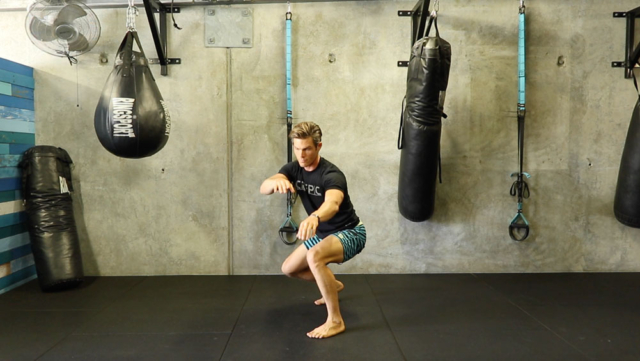
Este es el punto en el que la práctica real de pop up en tierra firme es muy beneficiosa. Incluso he recomendado a mis clientes que se hagan con una colchoneta de espuma y practiquen en surf. Practica la destreza.
Digamos que tienes esa sentadilla profunda de culo a hierba, así que sabes que no es una restricción de movimiento.
Tal vez seas demasiado débil. Tal vez esos pequeños y débiles brazos estén demasiado agotados de remar y tener que esquivar algunas olas fijas.
Así que cuando va a subir no hay suficiente resistencia en tus músculos de empuje para proporcionar un empuje rápido y fluido para balancear la parte inferior de tu cuerpo debajo de ti.
Evalúe sus limitaciones. Elimínelas. Aumenta la movilidad y la fuerza funcional. Añade la práctica de habilidades esenciales. Boom. Arregla tu Surf Pop Up .
CÓMO MEJORAR LA HABILIDAD REAL SURF POP UP
Puede ser que tu destreza sea sencillamente pésima y que hayas incrustado en tu sistema nervioso un patrón de movimiento menos que óptimo.
Simplemente tendrías que practicar una técnica perfecta en un entorno no estresante surf , y seguir progresando en ese sentido en diferentes situaciones de olas. Aquí es donde la práctica experta de pop up en casa o en el gimnasio adquiere una gran relevancia.
Como he mencionado antes en el artículo, la técnica puede variar, y de hecho varía, de una persona a otra, dependiendo de las lesiones, la edad y el tipo de tabla de surf. Profundizo en la técnica, así como en todo el proceso de evaluación para encontrar tus limitaciones y fortalecer tu cuerpo específicamente para un buen pop up, y mejorar tu surf-tiempo en mi Programa Arregla Tu Pop Up .
Podrías tener sólo uno de esos problemas, como una cadera tensa o un tobillo limitado, tal vez un núcleo débil y un hombro malo, o combinaciones de esos problemas. Tener claras tus limitaciones específicas es la clave para arreglar de verdad tu pop up, y trabajar una habilidad sin esfuerzo.
THE MENTAL GAME TO FIXING YOUR POP UP

He hablado de cómo un movimiento hábil ya está arraigado en tu sistema nervioso. Pero de lo que no he hablado es de la amenaza y la ansiedad, y de cómo eso detendrá inmediatamente el aprendizaje.
Gran parte del buen surf consiste en la capacidad de leer el océano. Ver las líneas del oleaje y tomar decisiones sobre dónde y cómo va a romper la ola. La velocidad a la que la inercia de esta ola golpeará el arrecife y lo rápido que se levantará. Esta "lectura" te permite adoptar una posición mejor informada sobre tu pop up.
¿Se levantará y requerirá una mayor velocidad pop up, o es un despegue cónico que le permitirá llegar casualmente a sus pies? Veo tantos pop ups fallidos debido a la ineficacia de la lectura surf. Esto es algo realmente difícil de enseñar y veo que realmente sólo se desarrolla con más tiempo en el océano.
Sin embargo, lo que sí puedes trabajar es tu mentalidad y tu reacción ante la ola y el océano.

Cuando trabajas en una habilidad quieres eliminar variables para poder trabajar realmente en la fluidez de lo que sea esa habilidad. Quieres tener cero ansiedad. Ninguna frustración. Tener una mente zen. Despeja el camino para que el sistema nervioso aprenda el patrón de movimiento.
Puedes ponerlo en práctica trabajando los ejercicios de pop up en tierra firme. En mi Programa Arregla Tu Pop Up hablo con detalle de las técnicas y ejercicios específicos. Necesitas eliminar las variables de estrés e incertidumbre para perforar el patrón.
Si te metes en el océano, te abruman los demás surfistas, te entra ansiedad por la surf, y te estresas demasiado por la perfección de la pop up, la mejora de la habilidad está muerta. Cuando estás bajo amenaza, o a alta velocidad, es probable que tu cuerpo vuelva a ese viejo patrón que conoce demasiado bien, el torcido pop up.
La velocidad es clave a la hora de coger olas, ejecutar giros y realizar trucos.
Por eso es crucial que practiques tu técnica perfecta de pop up en tierra firme. Y luego, idealmente, ve a practicarla en surf limpio, de un tamaño que no te resulte en absoluto amenazador. También necesitas una sonrisa en la cara. Lo digo en serio. Entra en ese espacio cerebral de disfrute, diversión y felicidad, porque el estrés y el exceso de pensamiento acabarán con el proceso de adquisición de habilidades.
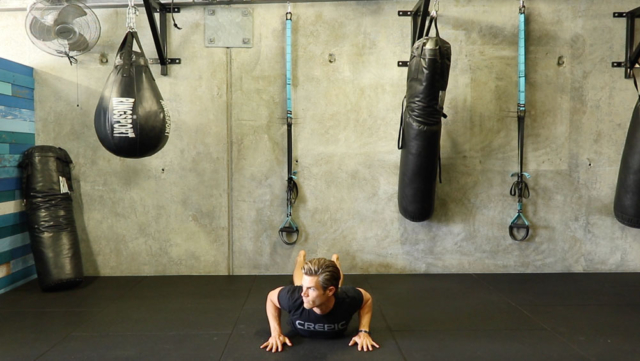
Incorporar el entrenamiento en tierra firme a tu rutina te ayudará a crear la memoria muscular y la confianza necesarias para realizar la habilidad con suavidad y eficacia, y con velocidad. Los ejercicios en tierra firme te permiten centrarte únicamente en el patrón de movimiento sin las variables añadidas del entorno oceánico. Además, puedes seguir tus progresos y realizar ajustes en tu técnica más fácilmente en tierra firme. Por tanto, asegúrate de incorporar el entrenamiento en tierra firme como parte habitual de tu proceso de adquisición de habilidades.
Now go and Fix Your Pop Up.

Respeta el hecho de que requerirá repetición, y esos pro pop ups que has visto se han incrustado en sus cuerpos con miles y miles de repeticiones.
¿LE FRUSTRA SU SURF POP UP ?
If you’re frustrated with your pop up, and want to simply surf more fluidly, and get to your feet with ease, you’ll love my Fix Your Pop Up Program.


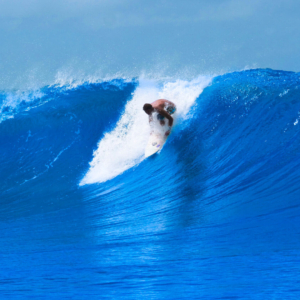
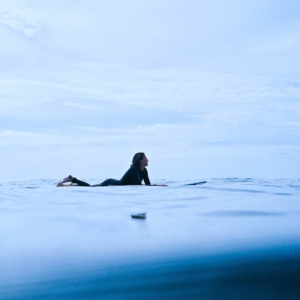
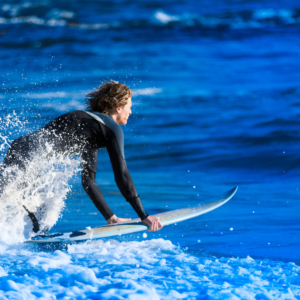

Comentario